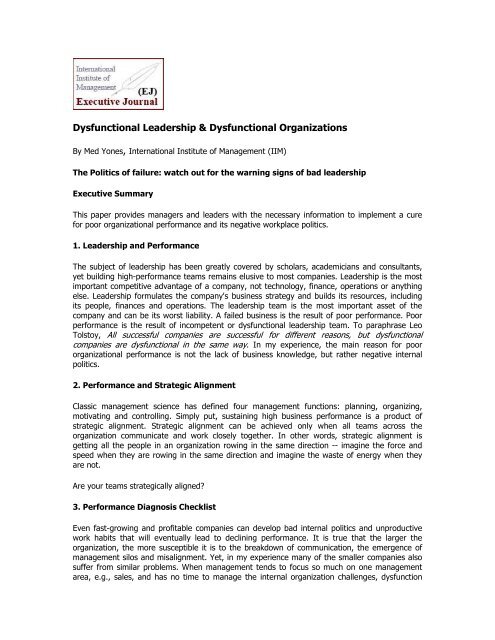Dysfunctional Leadership & Dysfunctional ... - LesAffaires.com
Dysfunctional Leadership & Dysfunctional ... - LesAffaires.com
Dysfunctional Leadership & Dysfunctional ... - LesAffaires.com
Create successful ePaper yourself
Turn your PDF publications into a flip-book with our unique Google optimized e-Paper software.
<strong>Dysfunctional</strong> <strong>Leadership</strong> & <strong>Dysfunctional</strong> OrganizationsBy Med Yones, International Institute of Management (IIM)The Politics of failure: watch out for the warning signs of bad leadershipExecutive SummaryThis paper provides managers and leaders with the necessary information to implement a curefor poor organizational performance and its negative workplace politics.1. <strong>Leadership</strong> and PerformanceThe subject of leadership has been greatly covered by scholars, academicians and consultants,yet building high-performance teams remains elusive to most <strong>com</strong>panies. <strong>Leadership</strong> is the mostimportant <strong>com</strong>petitive advantage of a <strong>com</strong>pany, not technology, finance, operations or anythingelse. <strong>Leadership</strong> formulates the <strong>com</strong>pany's business strategy and builds its resources, includingits people, finances and operations. The leadership team is the most important asset of the<strong>com</strong>pany and can be its worst liability. A failed business is the result of poor performance. Poorperformance is the result of in<strong>com</strong>petent or dysfunctional leadership team. To paraphrase LeoTolstoy, All successful <strong>com</strong>panies are successful for different reasons, but dysfunctional<strong>com</strong>panies are dysfunctional in the same way. In my experience, the main reason for poororganizational performance is not the lack of business knowledge, but rather negative internalpolitics.2. Performance and Strategic AlignmentClassic management science has defined four management functions: planning, organizing,motivating and controlling. Simply put, sustaining high business performance is a product ofstrategic alignment. Strategic alignment can be achieved only when all teams across theorganization <strong>com</strong>municate and work closely together. In other words, strategic alignment isgetting all the people in an organization rowing in the same direction -- imagine the force andspeed when they are rowing in the same direction and imagine the waste of energy when theyare not.Are your teams strategically aligned?3. Performance Diagnosis ChecklistEven fast-growing and profitable <strong>com</strong>panies can develop bad internal politics and unproductivework habits that will eventually lead to declining performance. It is true that the larger theorganization, the more susceptible it is to the breakdown of <strong>com</strong>munication, the emergence ofmanagement silos and misalignment. Yet, in my experience many of the smaller <strong>com</strong>panies alsosuffer from similar problems. When management tends to focus so much on one managementarea, e.g., sales, and has no time to manage the internal organization challenges, dysfunction
creeps in and takes hold. To build and sustain high-performance teams, leadership and humanresources managers should keep an eye open for the following symptoms and treat the rootcauses before it be<strong>com</strong>es too late.<strong>Dysfunctional</strong> leadership symptoms and warning signs:• Dictatorial <strong>Leadership</strong>: Management that does not allow disagreements out of insecurity orarrogance• No 360 Degrees Feedback: There is limited or no leadership performance feedback• Personal Agendas: Recruitments, selections and promotions are based on internal politicalagenda, for example hiring friends to guarantee personal loyalty at the expense of otherhighly performing and more-qualified employees• Political Compensation: Stock options, bonuses and perks are not fairly linked toperformance.• Inefficient Use of Resources: Budgets are allocated between business units or departmentsbased on favoritism and power centers rather than actual business needs.• Empire-building Practices: Managers believe that the more people they manage and thebigger the budget, the higher the chance that they will be promoted. This results in ragingbattles around budgets, strategies and operations.• Unequal Workload Distribution: You'll find some departments are underutilized while otherdepartments are overloaded• Too Much Management: There are many management layers in the organization, thus,hindering <strong>com</strong>munication and resulting in slower execution• Fragmented Organization Efforts: Interdepartmental <strong>com</strong>petition and turf wars between rivalmanagers lead to the emergence of silos, which results in <strong>com</strong>munication gaps. Managementsilos almost always result in fragmented and duplicated budgets and projects, thus wastingvaluable <strong>com</strong>pany investments.• Too Much Talk: Plans are heavy on talk but light on action. In a political corporate culture,image management be<strong>com</strong>es far more important than actions.• Ineffective Meetings: Argumentative and heated cross-divisions meetings with discussion andlanguage focusing on point scoring and buck-passing rather than sharing responsibility andcollaborating to solve the problem• Lack of Collaboration: Every person for himself/herself. Low sense of unity or camaraderie onthe team. The key criterion for decision-making is What is in it for me?• Low Productivity: Management wastes more time and energy on internal attack and defensestrategies instead of executing the work, innovating and over<strong>com</strong>ing challenges. Criticalprojects fall behind on deadlines, budgets and performance targets (e.g. sales, market share,quality and other operational targets)• Constant Crisis Mode: Management team spends most of their time on fire fighting instead ofproactive planning for next-generation products and services• Morale Deterioration: Muted level of <strong>com</strong>mitment and enthusiasm by other teams. Evensuccessful results cannot be shared and celebrated due to animosity and internal negative<strong>com</strong>petition• Backstabbing: Backbiting among the executives and managers be<strong>com</strong>es <strong>com</strong>mon and public• Highly Stressful Workplace: There is a high rate of absenteeism and a high employeeturnover rate.
4. Bad Politics and Performance Risks• When employees feel discriminated against, abused or unappreciated, they may resort to oneor more of the following harmful options:o Defecting to <strong>com</strong>petitiono Resort to sabotaging the <strong>com</strong>pany, e.g., by sharing confidential information with<strong>com</strong>petitors or the mediao Employees may be<strong>com</strong>e emotionally distant and have no interest in the success ofthe <strong>com</strong>panyo They will display passive-aggressive behaviors, be<strong>com</strong>e uncooperative, work less orproduce substandard results• Key talent will leave the <strong>com</strong>pany. Good honest workers generally don't have the skills ordisposition for functioning in a highly political environment.• Company develops a reputation for being political and an unpleasant place to work, making itmore difficult to recruit good talent to <strong>com</strong>pete effectively.• Employees will lose faith and motivation. When the leadership <strong>com</strong>es up with good initiatives,they are met with skepticism and resistanceThe Bottom line: Business performance will suffer.The worst thing that could happen to a <strong>com</strong>pany is when the staff loses confidence in theleadership team.The 2 critical questions every leader must ask:• How many of the above-listed symptoms are present in our organization, department orteams?• How best to manage workplace politics and improve team performance?5. Treatment ChallengesWhy is it so difficult to treat dysfunctional teams and organizations?• Many times the leadership team is part of the political game.• There is a lack of consensus on the correct strategy: strong conflicting views or conflict ofinterests.• New leaders are not able to assess who is right or wrong because of lack of information ormisinformation.• Changing the culture requires performance-rewards system reengineering, which may befaced with serious resistance• It takes substantial time and effort to heal the wounds, to reestablish broken<strong>com</strong>munications and rebuild trust and collaboration
6. Best Practices for Curing Bad Politics:Realistically, it is not possible to have a politics-free organization. The desire for power is part ofhuman nature, our business, and our world. Seeking power and politics in any <strong>com</strong>pany is neitherinherently good nor bad. However, successful leaders know how to leverage politics by settingperformance-oriented instead of resources-oriented political goals and rewards. Successfulleaders set fair rules for the political game, reward collaborative performance and penalizeanimosity and negative behavior. To cure the organization from bad politics, the board ofdirectors and investors can choose from the following list of re<strong>com</strong>mendations:• The CEO must recognize the criticality of the political problem and its impact on the businessperformance. S/he must <strong>com</strong>mit to change and be its leading champion• The CEO can use independent and qualified advisors/facilitators to support the changeprogram (outsiders who have no internal agendas or biases)• The CEO must use adequate scorecards and open employee-feedback surveys to assess thehealth and performance of the management team, and to identify performance roadblocks.The surveys must be anonymous and conducted by independent consultants on a biquarterlybasis• For valid differences of opinions, consider mediation and arbitration. If that does not work,replace difficult and uncooperative managers.• If the existing management team does not demonstrate a true change of heart and policy,then a new powerful leadership must be brought in• If a new leadership is brought in, s/he must be backed by the full support of the board ofdirectors. The new CEO/leader must be given the power to make decisions, hire, fire and endbad politics.• The leader must gather the team together and be honest and direct about bad politicalbehaviors and should be willing to back threats with actions. It is important to have the legalcounsel be present and announce that those who continue in their negative behavior will beout the door.• To quote Gandhi: "Be the change you want to see.” The most powerful leaders are almostalways the role models for the change they seek. If the CEO practices bad politics, noamount of training or coaching will change the management team.• Do not tolerate bad behavior. Realize that both bad and good behaviors are contagious. It isa proven sociological fact that people will imitate the behavior that appears to be sociallyacceptable, even if it is not their normal behavior. If you allow some people to get away withbad political behaviors, other people will follow.• Focus on building a culture of collaboration as part of the management strategy. The processof building a healthy organization starts by creating cohesive teams at all levels (top, middleand line managers). Leverage executive-coaching programs and action-learning teams tosolve problems and develop strategies. Learning together helps them to work better together• Conduct <strong>com</strong>pany-wide team building workshops, educate teams on professional ethics andtrain them on people skills, <strong>com</strong>munication, negotiation and conflict resolution• Communicate, educate and build consensus on strategy, direction and performance targets• Once a strategy is agreed upon, design a performance system to motivate and control -include both incentives and penalties. The new system must be aligned with objectives anddesigned to reward collaboration and penalize silos• Use collaboration tools (Information and <strong>com</strong>munication technologies) betweengeographically dispersed business units and teamsCopyright LicenseRoyalty-free license is granted for using or publishing for educational purposes provided that thepublisher includes a clear reference to the author(s) and International Institute of Managementwww.iim-edu.org




